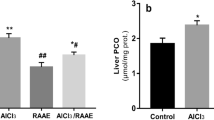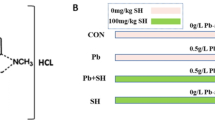Abstract
Increasing entrance of aluminum chloride (AlCl3) in many fields exposes human beings to its biotoxicity. Thereby, the present study assesses the potential ameliorative role of curcumin phytosome (CP) on AlCl3-induced hepatotoxicity. Rats were divided into four groups (n = 6): group 1 served as control; group 2 received CP (200 mg CP/kg b.wt) for 21 days; group 3 injected three doses of AlCl3 (30 mg/kg/body weight) every 5 days intraperitoneally; group 4 received CP for 7 days prior to AlCl3 and then received CP concurrently with AlCl3 for another 14 days. AlCl3 markedly increased (P < 0.05) the concentrations of AST, ALT, ALP, LDH, total bilirubin, and LPO as well as depleted (P < 0.05) albumin, GSH, SOD, and GPx stores in comparison to the control group. These biochemical alterations supported by the lesion observed in histological sections, increasing the expression of caspase-3 and decreasing the expression of Bcl-2. Treatment with CP modulates the hepatic dysfunction, boosting the endogenous antioxidant status, downregulating the expression of caspase-3, and upregulating the expression of Bcl-2. This hepatic ameliorative effect may be mediated by the ability of CP to repair the oxidant/antioxidant equilibrium rather than its ability to suppress apoptosis.




Similar content being viewed by others
References
Abdel Moneim AE, Othman MS, Mohmoud SM, El-Deib KM (2013) Pomegranate peel attenuates aluminium-induced hepatorenal toxicity. Toxicol Mech Methods 23(8):624–633
Abu Aita NA (2014) Hepatoprotective effect of Spirulina platensis against aluminium chloride induced liver damage in rats. Glob Vet 13(4):552–559
Adedosu OT, Adeleke GE, Alao TA, Ojugo NE, Akinsoji OE (2018) Effects of vitamin E administration on certain biochemical and antioxidants indices in some rat tissues treated with aluminium chloride. Annu res rev biol 27(4):1–13
Ahmed NM, Hamaad FAM (2018) Assistant protective effects of Açai in combination with vitamin C against aluminium-induced toxicity in rat liver. J Biol Life Sci 9(1). https://doi.org/10.5296/jbls.v9i1.11670
Al Eisa R, Al Nahari H (2016) Biology protective effect of royal jelly against the liver toxicity caused by aluminium chloride (AlCl3) in adult male rats. Adv Environ Biol 10(3):113–117
Al-Olayan EM, El-Khadragy MF, Abdel Moneim AE (2015) The protective properties of melatonin against aluminium-induced neuronal injury. Int J Exp Pathol 96(3):196–202
Asha S, Radha E (1985) Effect of age and myocardial infarction on serum and heart lactic dehydrogenase. Exp Gerontol 20(1):67–70
Balgoon MJ (2019) Assessment of the protective effect of Lepidium sativum against aluminum-induced liver and kidney effects in albino rat. Biomed Res Int 2019. https://doi.org/10.1155/2019/4516730
Belfield A, Goldberg D (1971) Colorimetric determination of alkaline phosphatase activity. Enzyme 12:561–566
Beutler E, Duron O, Kelly BM (1963) Improved method for the determination of blood glutathione. J Lab Clin Med 61:882–888
Bhatti JS (2014) Ameliorative role of melatonin against cypermethrin induced hepatotoxicity and impaired antioxidant defense system in Wistar. IOSR J Environ Sci Toxicol Food Technol 8(1):39–48
Bouasla I, Bouasla A, Boumendjel A, El Feki A, Messarah M (2014) Antioxidant effect of alpha lipoic acid on hepatotoxicity induced by aluminium chloride in rats. Int J Pharm Sci Rev Res 29(2):19–25
Cheraghi E, Roshanaei K (2019) The protective effect of curcumin against aluminum chloride induced oxidative stress and hepatotoxicity in rats. Pharm Biomed Res 5(1):11–18
Cheraghi E, Golkar A, Roshanaei K, Alani B (2017) Aluminium-induced oxidative stress, apoptosis and alterations in testicular tissue and sperm quality in Wistar rats: ameliorative effects of curcumin. Int J Fertil Steril 11(3):166–175
Dai C, Xiao X, Li D, Tun S, Wang Y, Velkov T, Tang S (2018) Chloroquine ameliorates carbon tetrachloride-induced acute liver injury in mice via the concomitant inhibition of inflammation and induction of apoptosis. Cell Death Dis 9(12):1164. https://doi.org/10.1038/s41419-018-1136-2
Doumas BT, Watson WA, Biggs HG (1971) Albumin standards and the measurement of serum albumin with bromcresol green. Clin Chim Acta 31(1):87–96
El-Gazayerly ON, Makhlouf AI, Soelm AM, Mohmoud MA (2014) Antioxidant and hepatoprotective effects of silymarin phytosomes compared to milk thistle extract in CCl4 induced hepatotoxicity in rats. J Microencapsul 31(1):23–30
Fadus MC, Lau C, Bikhchandani J, Lynch HT (2016) Curcumin: an age-old anti-inflammatory and anti-neoplastic agent. J Tradit Complement Med 7(3):339–346
Farzaei MH, Zobeiri M, Parvizi F, El-Senduny FF, Marmouzi I, Coy-Barrera E, Naseri R, Nabavi SM, Rahimi R, Abdollahi M (2018) Curcumin in liver diseases: a systematic review of the cellular mechanisms of oxidative stress and clinical perspective. Nutrients 10(7):E855. https://doi.org/10.3390/nu10070855
Hasona NA, Ahmed MQ (2017) Antioxidant and ameliorative effects of Zingiber officinale against aluminium chloride toxicity. Int J Chin Med 1(4):124–131
Huyut Z, Beydemir Ş, Gülçin İ (2017) Antioxidant and antibacterial properties of selected flavonoids and phenolic compounds. Biochem Res Int 2017:7616791. https://doi.org/10.1155/2017/7616791
Ige SF, Adeniyi MJ, Iyalla GO (2017) Allium cepa mitigates aluminium chloride-induced hepatotoxicity in male Wistar rats. J Biomed Sci 6(4):27. https://doi.org/10.4172/2254-609X.100071
Ireson C, Orr S, Jones DJ, Verschoyle R, Lim CK, Luo JL, Howells L, Plummer S, Jukes R, Williams M, Steward WP, Gescher A (2001) Characterization of metabolites of the chemopreventive agent curcumin in human and rat hepatocytes and in the rat in vivo, and evaluation of their ability to inhibit phorbol ester-induced prostaglandin E2 production. Cancer Res 61:1058–1064
Ling J, Söll D (2010) Severe oxidative stress induces protein mistranslation through impairment of an aminoacyl- tRNA synthetase editing site. Proc Natl Acad Sci U S A 107:4028–4033
Lu SC (2009) Regulation of glutathione synthesis. Mol Asp Med 30(1–2):42–59
Marczylo TH, Verschoyle RD, Cooke DN, Morazzoni P, Steward WP, Gescher AJ (2007) Comparison of systemic availability of curcumin with that of curcumin formulated with phosphatidylcholine. Cancer Chemother Pharmacol 60:171–177
Montgomery HAC, Dymock JF (1961) Colorimetric determination of nitrite. Analyst 86:414
Nishikimi M, Roa NA, Yogi K (1972) Measurement of superoxide dismutase. Biochem Biophys Res Commun 46:849–854
Okhawa H, Ohishi N, Yagi K (1979) Assay for lipid peroxides in animal tissue by thiobarbituric acid reaction. Anal Biochem 95:351–358
Olorunnisola OS, Bradley G, Afolayan AJ (2012) Protective effect of T. violacea rhizome extract against hypercholesterolemia-induced oxidative stress in Wistar rats. Molecules 17(5):6633–6645
Paglia DE, Valentine WN (1967) Studies on the quantitative and qualitative characterization of erythrocyte glutathione peroxidase. J Lab Clin Med 70(1):158–169
Reitman S, Frankel SA (1957) Colorimetric method for the determination of serum glutamic oxalacetic and glutamic pyruvic transaminases. Am J Clin Pathol 28(1):56–63
Siviero A, Gallo E, Maggini V, Gori L, Mugelli A, Firenzuoli F, Vannacci A (2015) Curcumin, a golden spice with a low bioavailability. J Herbal Med 5(2):57–70
Suryawanshi JAS (2011) Phytosome: an emerging trend in herbal drug treatment. J Med Genet Genomics 3(6):109–114
Suvarna SK, Layton C, Bancroft JD (2013) Time course of cadmium-induced acute Bancroft’s theory and practice of histological techniques, 7th edn. Churchill Livingstone Elsevier, London
Tahari FZ, Lablack M, Hamadouche NA, Tahari Z, Aoues A (2016) Protective effect of Haloxylon salicornicum on hepatic and renal functions of Wistar rats exposed to aluminium. Afr J Biotechnol 15(9):293–302
Taïr K, Kharoubi O, Taïr OA, Hellal N, Benyettou I, Aoues A (2016) Aluminium-induced acute neurotoxicity in rats: treatment with aqueous extract of Arthrophytum (Hammada scoparia). J Acute Dis 5(6):470–482
Taverna M, Marie AL, Mira JP, Guidet B (2013) Specific antioxidant properties of human serum albumin. Ann Intensive Care 3(1):4. https://doi.org/10.1186/2110-5820-3-4
Tsuchiya H (2015) Membrane interactions of phytochemicals as their molecular mechanism applicable to the discovery of drug leads from plants. Molecules 20(10):18923–18966
Tung BT, Hai NT, Son PK (2017) Hepatoprotective effect of phytosome curcumin against paracetamol-induced liver toxicity in mice. Braz J Pharm Sci 53(1):e16136
Walter M, Gerade H (1970) A colorimetric method for determination bilirubin in serum and plasma. Micro Chem J 15:231–236
Wang B, Zhu Y, Zhang H, Liu L, Li G, Song Y, Li Y (2016) Effect of aluminium chloride on serum proteins, bilirubin, and hepatic trace elements in chickens. Toxicol Ind Health 32(9):1693–1699
Willhite CC, Ball GL, McLellan CJ (2012) Total allowable concentrations of monomeric inorganic aluminium and hydrated aluminium silicates in drinking water. Crit Rev Toxicol 42:358–442
Yuan CY, Yih-Jing Lee YJ, Hsu GW (2012) Aluminium overload increases oxidative stress in four functional brain areas of neonatal rats. J Biomed Sci 19:51
Zahedi-Amiri Z, Taravati A, Hejazian LB (2018) Protective effect of Rosa damascene against aluminium chloride-induced oxidative stress. Biol Trace Elem Res 187:27–127. https://doi.org/10.1007/s12011-018-1348-4
Funding
The authors extend their appreciation to the Deanship of Scientific Research at King Khalid University, Abha, KSA for funding this work through Research Group Project under grant number R.G.P.1–117–40.
Author information
Authors and Affiliations
Corresponding author
Ethics declarations
The experimental protocols using the animals were conducted in accordance with the Guide for the Care and Use of Laboratory Animals (8th edition) and approved by the scientific committee of Cairo University, Egypt, with approval number of CU/I/F/51/18.
Additional information
Responsible editor: Philippe Garrigues
Publisher’s note
Springer Nature remains neutral with regard to jurisdictional claims in published maps and institutional affiliations.
Rights and permissions
About this article
Cite this article
Al-Kahtani, M., Abdel-Daim, M.M., Sayed, A.A. et al. Curcumin phytosome modulates aluminum-induced hepatotoxicity via regulation of antioxidant, Bcl-2, and caspase-3 in rats. Environ Sci Pollut Res 27, 21977–21985 (2020). https://doi.org/10.1007/s11356-020-08636-0
Received:
Accepted:
Published:
Issue Date:
DOI: https://doi.org/10.1007/s11356-020-08636-0




